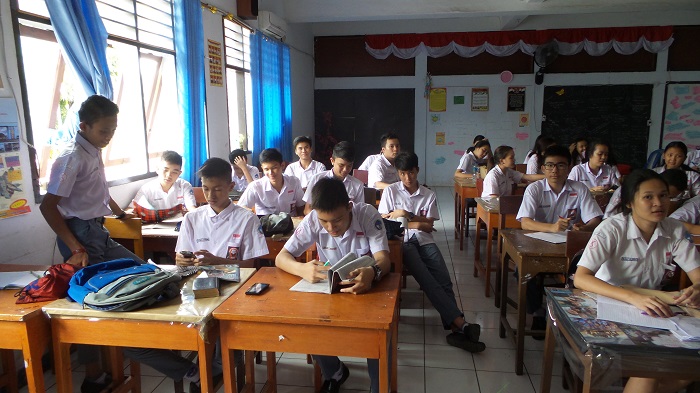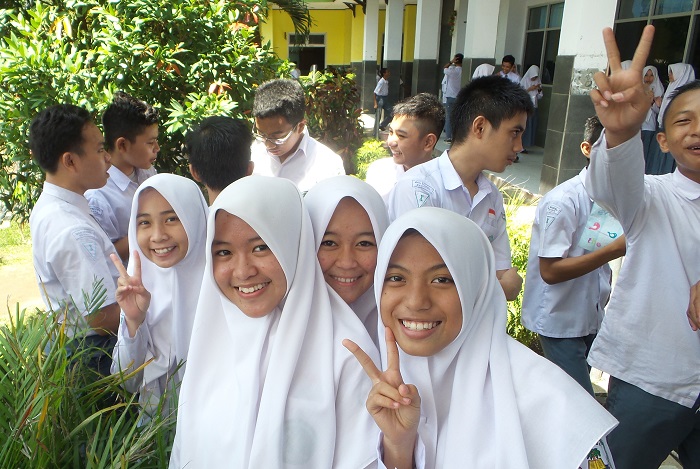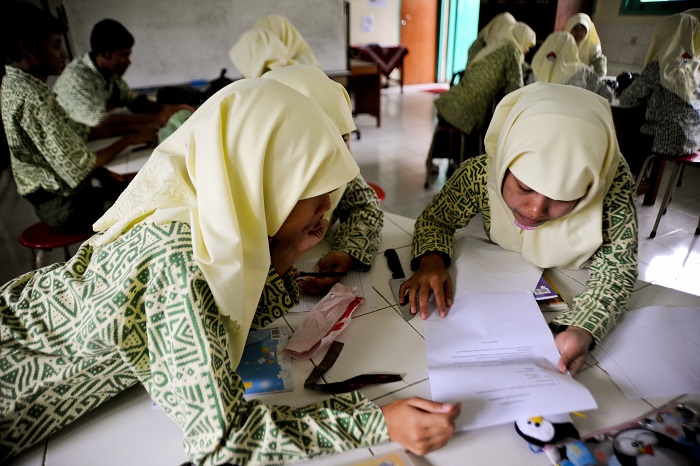Lessons and beliefs on inter-religious mixing can get messy for youth in Manado
When I asked Muslim high school students at a madrasah in Manado, North Sulawesi, about their experience interacting with someone of a different religion, their teacher teased them, in jest, suggesting none would have non-Muslim friends. Aisyah in the front row wearing a white jilbab rebutted her: ‘Yes, everyone does! Of course they do!’
Manado is a majority-Protestant city within the world’s largest predominantly Muslim country. It was named the most tolerant city in Indonesia in 2017 by Setara Institute for Democracy and Peace. Its religiously and ethnically diverse residents take pride in the city’s reputation for inter-religious harmony. However, Manado is not immune to the current national climate in which tensions along religious lines are heightened. Against this background, how do youth learn about religious difference in schools? How does it play out in practice in their social lives?
Although Christian and Muslim youth in Manado generally agree that religious tolerance is important, the question of how to embrace diversity and coexist peacefully remains messy.
Multicultural education
In response to past communal conflicts and the rising influence of Muslim hardliners in more recent years, educators have worked to introduce conversations about diversity and national unity through various avenues, including civic education. A renewed emphasis on the national ideology of Pancasila is one strategy. However, Pancasila’s ability to serve as a contemporary basis for respecting diversity is complicated by its oppressive interpretation during the authoritarian Suharto era (1966-1998). School textbooks from the latest curriculum reforms in 2013 propose new interpretations of diversity that allow the mention of identities previously considered taboo during the Suharto era. For example, in civic education courses at a public high school in Manado, students read from a government-approved textbook about respecting others as citizens, valuing difference and avoiding discrimination based on ethnicity, religion, race and gender.

The 2013 national curriculum overhaul did not integrate an explicitly multicultural education program, but instead focused on introducing character education in all subjects. For the Ministry of Education and Culture, practicing tolerance stems from individual commitment to religious values supporting peace and coexistence. For example, government-produced Islamic education textbooks now include a chapter on ‘Tolerance as the unifying mechanism of the nation’. Officially, religious education in any of the six official religions is intended to build character and give a strong religious foundation to prevent both radicalism and intolerance. Ibu Sonia, a teacher, proclaimed during the Protestant religious education class at a public high school, ‘If we were able to follow our religion well – whether Muslim, Catholic, Hindu, or Confucian – if we were all able to follow our respective teachings, there would be no conflict on earth!’
The 2013 curriculum also demands that teachers observe and assess students on their ability to form friendships across ethnicity, religion and social class. This is one of many core competencies in spiritual and social values that students have to demonstrate and all teachers must evaluate. But there are dozens of these competencies, leaving teachers overwhelmed by their grading responsibility and unable to pay specific attention to how students meet each requirement.
Civic and religious education teachers are proud of Manado’s reputation for religious harmony, and many can cite structural realities that support coexistence in the city, such as the BKSAUA (Committee for Inter-religious Cooperation). Yet, these local insights are often sidelined in the classroom for a focus on the textbook material. Examples cited by students and teachers tend to remain abstract, with minimal guidance on implementing these values in daily life.
Classroom discussions
During the lesson on respecting others as citizens, Ibu Pricilia, a teacher at a diverse public high school, asked students to brainstorm in groups about examples of behavior that show religious tolerance. From the first group, Brian stated that it is important to avoid insulting other religions. Another student, Evan, shouted out, ‘Don’t compare religious teachings!’ Grace spoke up for her group, ‘We have to keep harmonious inter-religious relations’. Ibu Pricilia nodded as she summarised that ‘religion is sensitive’. She explained that she is Protestant because she considers it the best religion for her, but those who are Muslim consider that the best religion for them. Throughout the lesson, the class moved mechanically from one topic to the next, giving additional examples of behavior that does not discriminate based on race or ethnicity.
In a civic education class at a madrasah, students also had difficulty identifying concrete ways to respect diversity and national unity as citizens. The teacher ultimately praised Rifqi, who offered an abstract response: that in order to respect diversity, national unity must be emphasized. The struggle to verbalise concrete approaches to difference belies a broader assumption among both teachers and students that how to handle difference should be self-evident for anyone that respects diversity and national unity. In reality, it was not always so self-evident.
Inter-religious friendship
Many high school students, both Christian and Muslim, assert that being friends with someone of a different religion is simply ordinary, just like being friends with anyone else. Hesty, a student at the madrasah said of her Christian friends, ‘Their behavior is the same as my friends who share my religion. They’re good, and they don’t differentiate between their friends who share their religion and those who don’t’. Another proclaimed, ‘we are all the same in God’s eyes’ and that God created human diversity’.
It was the same at a private Catholic school near Manado. Sitting in the school’s dining hall, Angela, a Protestant student, denied the existence of cliques at the school, stating bluntly, ‘we can’t be racist’. Maria, a Catholic student at the same school, explained in English, ‘Hanging out with a friend is the same whether they have the same beliefs as me or not … because I think all that matters is that he or she is a good friend and we get along well’.
With a religiously and ethnically diverse student body, including a large cohort of Christian Papuan youth, both students and teachers are proud of their multicultural campus and particularly sensitive to religious differentiation. Students from different religious backgrounds openly socialize at the school and religious education teachers often select lessons on avoiding discrimination or engaging in inter-religious dialogue. But bridging ethnic difference proves more challenging: students struggle to share dorms with and socialize with the Papuan students.
In fact, even the seemingly self-evident practice of religious tolerance can get messy sometimes.
Limits
For Muslim youth, dilemmas about how to manage inter-religious friendship and simultaneously meet religious requirements often center on food. Eka has been best friends with her Christian neighbor since they were little and goes to her house daily. However, Eka is still concerned about eating there, and always goes home for dinner before returning to her friend’s house to continue hanging out. Others struggled with this reality, unsure about how to refuse food at their friends’ houses or parties in a polite way without offending them.
In Manado, both Christians and Muslims typically celebrate birthdays with buffet-style feasts and religious worship. Ayu, a Muslim teenager at the public school, said that she attends the parties of her Christian peers and ‘respects’ but does not participate in the worship. Others mentioned arriving late on purpose to avoid the worship portion. Meanwhile, Muhammad avoids birthday parties altogether because of the presence of pork and other meats, even though Christians typically provide a separate table of food for Muslim guests. One Muslim student spoke about her Christian friends offering halal food at parties as a moving demonstration of tolerance.
Beyond this, even though inter-religious friendship is a daily reality for many youth in Manado, the potential for religious conversion looms over their interactions with peers. With religious belonging taking on increased significance in the public sphere, it is not surprising that youth also feel the need for boundaries in inter-religious friendships.

Some believe that talking about difference can help diffuse concerns about conversion. A boy at the madrasah who has a Christian cousin explained that difference can be ‘the start of getting to know each other within the boundaries that are set up. Because if someone is strong in his beliefs, he will not follow others’ beliefs.’
For others, hanging out with someone of a different religion opens the door to questions about not just conversion but dating and even marrying across religious lines. Cita, a Muslim teenager, admitted to having a long-distance Christian boyfriend. Her peers at the madrasah teased her about it, adamant that their relationship was inappropriate. Cita still asserted, ‘I believe that if we are soul mates, we will surely be united despite having different religions’.
Religiously mixed marriages remain nearly impossible to register in Indonesia, and therefore typically involve the conversion of one partner. The prospect of conversion is extremely sensitive. At 15 years old, Cita is aware of this reality: ‘But I am confused – he and I have different religions. Am I the one who has to be willing to give up my religion? Because up until now, he is not willing to follow my religion, and I am still confused.’
Rani preferred to steer clear of inter-religious friendships in order to avoid a situation like Cita’s. Rani, a Christian, explained that she minimises contact with her Muslim classmates, especially boys, to prevent any kind of close friendship, and especially romantic temptation. ‘Who knows, we could like each other, because we’re still teenagers.’
In Rani’s Protestant religious education class at the public school, her teacher had told the class to choose friends who bring them ‘closer to Christ’ and help them become deeper in their own faith. At the public school, Christian youth encounter teachings about both the importance of respecting difference and about being surrounded by their own religious community being a positive influence.
Future of a diverse Indonesia
In Manado, inter-religious friendship is encouraged as a sign of tolerance. Locals also point to historical Christian-Muslim intermarriage in the region as the foundation for religious harmony. Nur, a student at the madrasah, says she has learned from her Christian relatives in her religiously-mixed family that ‘religious difference is not an obstacle’. She claims that her experience has led her to believe in the importance of having many different perspectives. However, youth still struggle to navigate inter-religious relationships. Some actively try to minimize difference. Others feel it necessary to point out difference so as to manage it, learn from one another, and also assuage ever-present fears of religious conversion. In the civic education curriculum, vague calls to ‘respect and value difference’ still assume that difference – especially religious difference – must be preserved.
Many youth in Manado say that they do not claim their religion has a monopoly on truth. As citizens of a religiously pluralistic society, this is a gesture of respect to others. Inside, however, many believe that they are following the singular path to salvation. Though their textbooks extol the virtues of inter-religious friendship and students believe them to be an ordinary fact of life, youth in Manado have many different ways of living out these friendships in real life.
Erica M Larson (emlarson@bu.edu) is a PhD candidate in Anthropology at Boston University.
